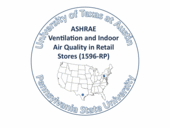Highlight
IGERT Trainees, Affiliates, and Faculty at Cutting Edge of Ventilation Research
Achievement/Results
During the past year, several trainees, affiliates and faculty participants of the National Science Foundation’s (NSF) Integrative Graduate Education and Research Traineeship (IGERT) program in Indoor Environmental Science and Engineering at The University of Texas (UT) participated in a large study on ventilation and indoor air quality in retails stores. This work is funded through a $1.45M grant from the American Society of Heating, Ventilating and Air Conditioning Engineers (ASHRAE) using funds from the American Recovery and Reinvestment Act of 2009 (ARRA) and is the largest project ever funded by ASHRAE. Additional funding from the Sloan Foundation is being used to increase the depth of the microbiological measurements in the study.
This work is enormously important because approximately 15 million Americans work in the retail sector, 20% of commercial building energy use is associated with retail stores, and individual stores expend 25-60% of their energy budget on the conditioning of ventilation air. The project involves detailed field measurements of numerous indoor air contaminants in large retail environments, simultaneous ventilation measurements, and surveys of store personnel. In addition to providing a comprehensive set of measurements, the results from this effort will be used to prepare the next generation of ventilation standards that will allow stores to optimize their ventilation for both indoor air quality and building energy use.
A total of six IGERT trainees and affiliates, as well as five IGERT faculty participants are involved in this research effort. Affiliates Marwa Farhat and Elena Nirlo are leading the ventilation, particle and aerosol, volatile organic compound (VOC), semi-volatile organic compound SVOC, and ozone measurements. Affiliate Andrew Hoisington is using DNA-based measurements to quantify and compare the microbiological communities in the stores. He is using a sampling approach that utilizes heating, ventilation, and air conditioning (HVAC) filters that was developed by affiliate alumnus Federico Noris. Trainee Shahana Khurshid is measuring reactive organic compounds and assessing their impact on human health. Affiliate Steven Bourne is collecting data on comfort and environmental parameters. Trainee Jorge Urquidi is conducting SVOC measurements, including extractions of the SVOCs from HVAC dust, the first time that this has been attempted.
The project has created several external and interdisciplinary collaborations, including a significant collaboration with Dr. Jelena Srebric at Penn State University. The research design of the study has been used as a teaching tool in a research methods course in the Department of Community and Regional Planning, Affiliate Andy Hoisington’s portion of the work is being completed at the Institute for Cellular and Molecular Biology on the UT campus. Trainee Shahana Khurshid’s work grew out of her IGERT internship at the National Institute for Occupational Safety and Health (NIOSH).
Address Goals
The research results are the first attempt to characterize the retail environment from an indoor air quality perspective. The set of contaminants that are being measured have a variety of important health and well-being effects and there is very little information about the occupational and casual exposures in retail environments, as well as the value of ventilation in limiting these exposures. The participation of IGERT trainees allows them to leverage this dataset to explore fundamental indoor chemistry and transport processes. This effort reflects important research discoveries made possible through the Indoor Environmental Science and Engineering IGERT program at the University of Texas at Austin.
This ongoing effort will result in numerous scientific and engineering journal publications, as well as changes to ASHRAE Standard 62.1, the preeminent international ventilation standard. The interactions with the communities who design, operate, and work in retail environments has allowed for a rich discussion on the role of indoor air quality and ventilation in buildings. Thus the IGERT faculty and students who are participating in this project are engaged in learning with academic, practitioner, and public communities.






